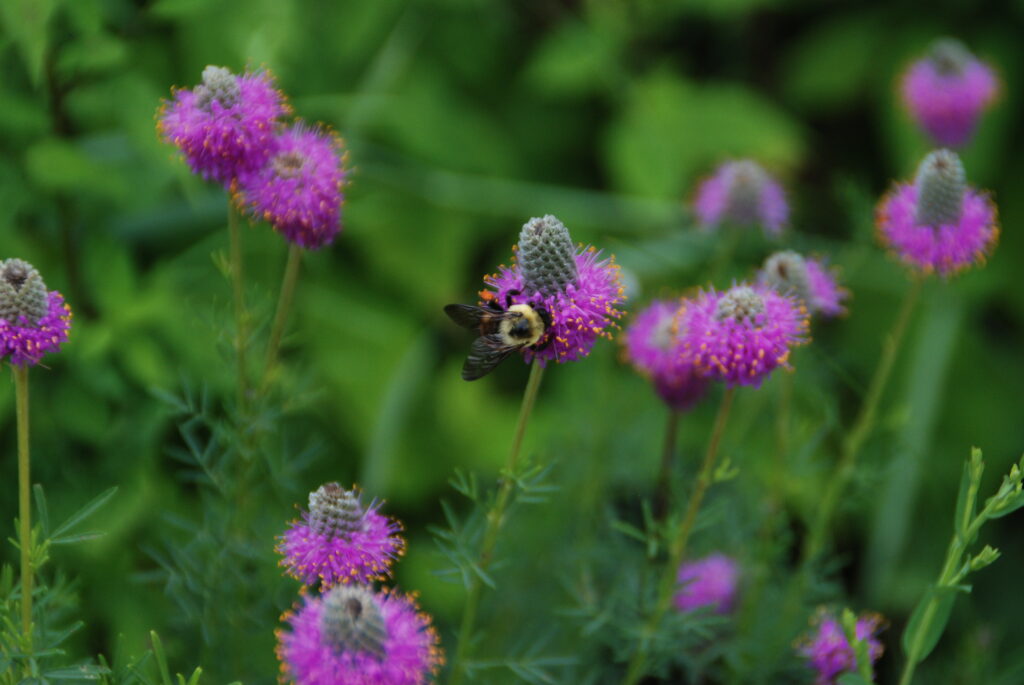by Melinda Myers
More and more gardeners are adding native plants to their landscapes. These plants provide more than beautiful flowers for us to enjoy. They also support pollinators and other beneficial insects and provide food and shelter for songbirds, toads, and other wildlife.
In addition, these plants help protect and improve our soil and manage stormwater. The plants slow stormwater runoff and help direct it into the soil through pathways created by their deep roots to the groundwater below. These deep roots also help break up compacted clay soils. Legumes like blue false indigo (Baptisia australis) that are hardy in zones 3 to 10 help add nitrogen to the soil while supporting a variety of pollinators.
Look to woodland native plants if you are gardening in the shade. Tall black cohosh (Actaea racemosa) grows 4 to 6 feet tall, has white flowers in summer, and is a host plant for the Appalachian azure butterfly. The spring-blooming native columbine’s (Aquilegia canadensis) red and yellow flowers provide food for hummingbirds and long-tongued insects. Wild ginger (Asarum canadense) makes an excellent groundcover that can hold its ground against garlic mustard and other invasive plants.
Perhaps you or members of your household have been reluctant to add these plants to your landscape. Some people worry that these plants won’t fit in with their current landscape design or be accepted by their neighbors. One option is to start including native plants in your landscape one plant or garden at a time.
As always, make sure the plants you select are suited to the growing conditions, your garden design, and the available space. Some native plants are aggressive and work best when given a lot of room to grow and spread. Others grow in clumps and slowly increase in size making them easier to include in smaller yards.
Common milkweed (Asclepias syriaca) is a wonderful but very aggressive native plant that’s a favorite of the monarch caterpillar. It spreads by seeds and deep rhizomes making it challenging to contain. Consider growing other native milkweeds that will support the monarch but are less aggressive when space is limited. Butterfly weed (Asclepias tuberosa) hardy in zones 3 to 10 is a great option for those with sunny well-drained locations. Red milkweed also known as swamp milkweed (Asclepias incarnata) also grows best in full sun, but this milkweed tolerates moist soils.
Think about substitutions when starting to add native plants to the garden. When one plant dies look for a native plant to fill the void. Consider one with a similar growth habit, texture, and bloom time. Prairie dropseed (Sporobolus heterolepsis) is a North American native grass with a growth habit similar to ornamental fountain grass (Pennisetum) and it provides many more benefits. Hardy in zones 3 to 8, it has uniquely fragrant flowers in late summer, golden fall color, and seeds that look like gems when covered with ice in the winter. It is also a host plant for six different moths and butterflies. This elegant grass is at home in just about any style garden.
As you get to know the native plants of your region and gain experience adding them to your gardens you may decide to create gardens of all native plants. Look to nature for some winning combinations. Combine plants that look good together, have the same growing conditions, and are equally assertive. When aggressive plants are mixed in with timid plants, you end up with a garden of just one or two overly assertive plants.
As always, do your research first. Visit nearby nature centers and talk to others growing native plants to gather information and inspiration. As you gain success and confidence, you are sure to find creative ways to add these beauties to your landscape.
Melinda Myers has written over 20 gardening books, including Midwest Gardener’s Handbook, 2nd Edition and Small Space Gardening. She hosts The Great Courses “How to Grow Anything” instant video and DVD series and the nationally syndicated Melinda’s Garden Moment radio program. Myers is a columnist and contributing editor for Birds & Blooms magazine. Myers’ website is www.MelindaMyers.com.
